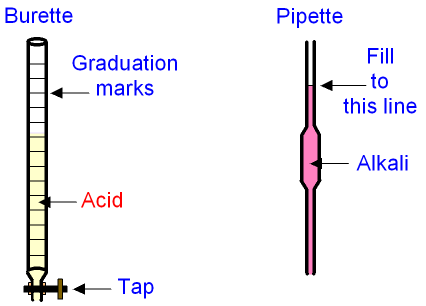
gcsescience.com 32 gcsescience.com
Using a Burette and a Pipette in a Titration.
What is a Burette?
A burette is a long glass tube with a tap at the bottom.
In a titration with an acid
and an alkali the burette is filled with acid.
The tap can be turned open allowing the acid
in the tube
to be added drop by drop into a conical flask.
The burette has graduation marks along it
which give the total volume of the acid at
that point.
The marks may be 2cm3 apart with smaller marks within them
giving a reading of the volume which
is accurate to 0·2cm3.
If the total volume of
acid is 100cm3 to begin with
and 54·7cm3 after neutralisation, then the amount of acid
used
is 100 - 54·7 = 45·3cm3

What is a Pipette?
A pipette is a long glass tube with a bulge
in the middle.
The pipette has a filling line marked on it
which precisely gives the volume at that point.
A pipette is used to place an accurate amount of alkali
into the conical
flask before the titration begins.
The alkali is sucked up into the pipette
until the liquid reaches
the filling line.
You must never use your mouth to suck up
alkali or any
other substance into the pipette.
You must always use a pipette
filler.
![]() Links
Acids
and Alkalis
Revision Questions
Links
Acids
and Alkalis
Revision Questions
![]()
gcsescience.com The Periodic Table Index Neutralisation Quiz gcsescience.com
Home GCSE Chemistry GCSE Physics
Copyright © 2015 gcsescience.com. All Rights Reserved.